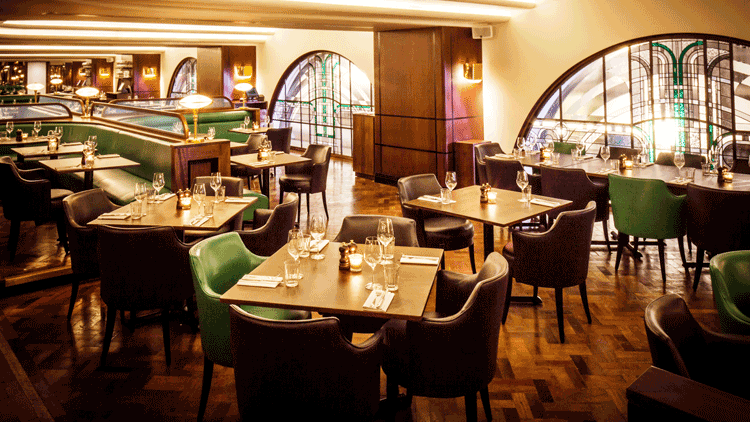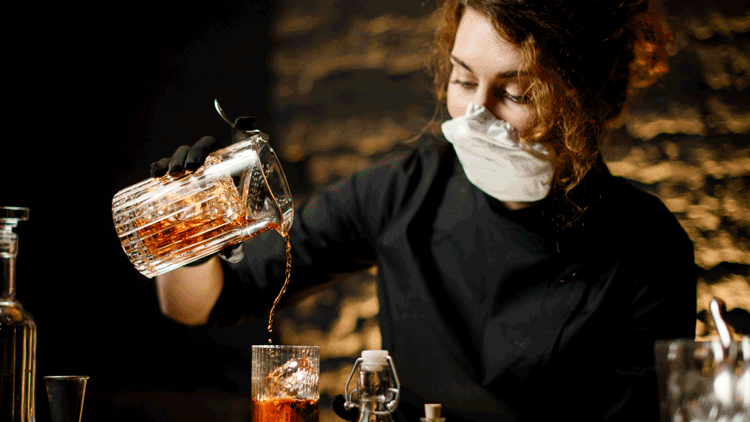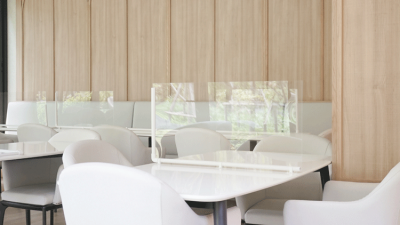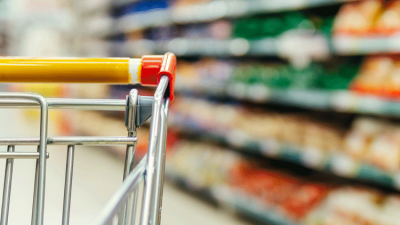The new (ab)normal? What the future holds for restaurants
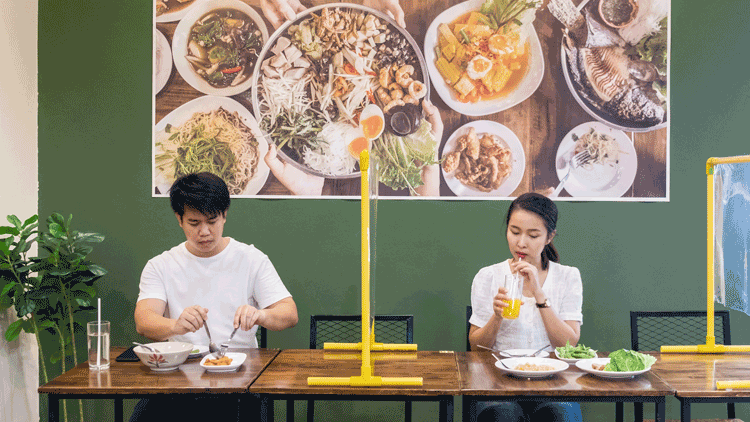
People eating in ‘quarantine’ greenhouses. Customers being greeted at the door by a member of staff armed with a thermometer. Perspex dividers on tables. Roped off areas in dining rooms (but not for VIPs). Crosses taped onto alternative chairs. Even customers wearing pool float hats to keep themselves apart. These are just some of the images of the ‘social distancing’ measures restaurants across the world have shared as they reopen their doors and attempt to return to some sort of normality.
Some are sensible, some rather silly but none can really be described as being in the spirit of hospitality – the business of bringing people together for conviviality, conversation, and food and drink. And yet this is the new (ab)normal in which restaurant and bar operators will soon find themselves.
With talk of the UK government beginning to lift its lockdown, with some hospitality businesses able to reopen from 4 July, restaurateurs are starting to prepare for a scenario in which staff must wear face masks and tables are placed two metres apart, moves that not only go against the grain of a buzzy hospitality environment but that will have huge ramifications on the number of covers they can do and thus potential turnover. In a sector where margins are already slim, many fear that without additional help the sector’s problems post lockdown will be insurmountable.
“It will deplete the industry very significantly,” says Dishoom co-founder Shamil Thakrar. “We need to get our heads around how to operate and still turn a buck. I’m really quite worried about it.”
Disappearing covers
The threat of social distancing measures to a restaurant businesses’ ability to make any money once it reopens is very real, according to Steve Holmes, CEO of Azzurri Group, which operates the high street casual dining brands Ask Italian, Zizzi and Coco di Mama.
“We’re in a very precarious position. Restaurants operate on thin margins and only having 50% of the space will massively impact profitability,” he says. “Our two biggest concerns are what the operational constraints are and how will they effect the business commercially.”
While the Government is yet to give clear guidance on the measures hospitality businesses need to put in place in order to reopen, it is widely believed it will impose a two-metre rule of distancing in line with the steps already taken by retailers. As a result, many businesses have already taken it upon themselves to get the tape measures out and start to plan what a post lockdown dining room might look like.
“I’d like to think the physically distanced
Dishoom is still a fantastic experience"
One such business is BrewDog, which has introduced a 10-point action plan for when its venues reopen in line with what it believes the Government will require. Actions include contactless ordering via its order at table app; staff wearing face masks and gloves at all times; amended furniture layouts to create appropriate space; single-use menus; and surface cleaning every 15 minutes.
“At various points in this journey the Government has been too slow to open up to the public and the business community about what the framework for reopening will or should be,” says BrewDog COO David McDowall. “We got to the point where we couldn’t keep waiting for people to hand us a manual. Looking at what’s happening elsewhere, I don’t think we are going to be a million miles away from what we propose. Operators have to forge ahead and find solutions.”
BrewDog is by no means alone. Azzurri’s Holmes says the results of its two-metre trial spacing of tables “looked very odd”, while Jo Fleet, managing director of steak restaurant group Flat Iron, describes its findings as “laughable” in terms of being able to run a successful restaurant.
Businesses with large and small restaurants face different obstacles but with similarly damaging results. “It’s difficult for us because most of our restaurants are very small,” says Tom Barton, co-founder of Honest Burgers. “We rely on high turnover and footfall and for us to lose half of our tables, if that’s what we will end up having to do, it is going to pose some challenges. But I don’t think they are insurmountable.”
Pizza group Pizza Pilgrims is in a similar boat. “We are supportive of social distancing, it’s the right thing to do, but we are a company built on small pizzerias with tables sometimes less than one metre apart,” says co-founder Thom Elliot. “We can all exist in hibernation state, but as soon as the doors are open and the furlough disappears and we only have 30% customers, that is not a business that can work.”
“One of the first things we did before we reopened Victoria [for delivery] was set the restaurant up using social distancing practices,” adds co-founder James Elliot. “Luckily, a pizza peel is two metres long, so it works nicely as a physical prodder to keep people away.”
Businesses with larger sites might be better placed to deal with social distancing measures but will take a bigger hit. “We have very large restaurants and the advantage is that we can get a lot of people in them,” says Thakrar. “But we have high fixed costs – the rents are really high.”
D&D London CEO Des Gunewardena says its venues, including German Gymnasium, Skylon and Quaglinos in London and 21 Stories in Manchester, will likely be the first to reopen by dint of their size. “It will generally be easier for the larger venues with more front of house space or big outdoor terraces where we can spread customers out a bit more,” he says. “As soon as we get the green light we will open – first with a few and feel our way through it. And assuming it looks viable then we will continue to reopen more.”
Gunewardena also believes that, even with capacity halved, the restaurant model might be viable. “If we take all fixed costs as given then yes you can in our restaurants make some profit at operating level at 50%.”
The death of the dining room?
The hit to covers isn’t the only worry for restaurant owners who fear that social distancing measures could have a more lasting impact on how people view restaurants. “Let’s say we can social distance and produce a layout with 50% capacity and everyone is wearing nice masks and cleaning the tables, is that an environment that customers want to come to?” asks Gunewardena. “We are all hoping the answer is ‘yes’.”
This is a question with which many in the industry have been wrangling. “I do question if that’s what customers come to restaurants for,” says Holmes. “We talk about restaurants as a business that sells experiences, we don’t really sell product. That sounds a bit odd as people come to a restaurant for food and it is very important, but they are really coming for a social experience. With people sat great distances apart, or restricted to tables of four, you lose an awful lot of that vibe and ambience of the restaurant. Will customers enjoy that kind of experience?
“There is a risk we could open too soon. What we really need is the government to tell consumers it’s safe to eat in restaurants to give them the confidence to return.”
For Hawksmoor co-founder Will Beckett, even running a dining room with the government go-ahead and with some of the proposed social distancing measures could result in long-lasting damage for businesses. “The key thing for us is not to be reopened during that public health risk phase.” he says.
“The biggest challenge is consumer confidence.
We are a resilient, forward thinking sector that can
come up with solutions"
“If politicians open bars and restaurants at a time when people need to stay two metres away from each other and staff have wear masks and use Perspex screens, they will do long term damage to the industry. The perception will stick that restaurants are not a safe place to be. We’ve got to get through that bit unopened.”
This is of particular concern to fine dining restaurants, where distancing measures could particularly jar. “Can you see someone coming over to you in a mask?,” says Sat Bains, chef-patron at two Michelin-starred Restaurant Sat Bains in Nottingham. “How do you get the intimacy and the looking after people, the things that restaurants are so used to doing? You’ve to question everything.”
Other operators are more optimistic, including BrewDog, which has a head start in that it has already reopened some of its venues in other countries where lockdown has been eased. According to MacDowell, in BrewDog’s albeit limited experience, customers have taken surprisingly well to social distancing measures.
“Three months ago, if you’d talked about going to a restaurant or pub with staff wearing a mask, we’d have been aghast. Is it ideal in delivering a warm hospitality experience? It is not. However, I would argue that at this time and what we're seeing is the customers feel more confident in that we have gone as far as we can with those [distancing] measures. It looks and feels a bit strange and consumers will have to get used to that for a period of time but it will help build confidence for them to come back.
“The biggest challenge is consumer confidence. We are a resilient, forward thinking sector that can come up with solutions, but two-metre distancing is very difficult. We need to make sure there is a programme of activity and that we get the message out to consumers as we open up again that they are going to be eating and drinking in a safe environment.”
Thakrar is also more positive about how customers will respond to social distancing measures. “We have got to work on the assumption that if the government says we can open then it’s safe and responsible to do so – but our first priority is safety.
“I’d like to think the physically distanced Dishoom is still a fantastic experience. We’ll have masks, maybe Perspex screens, and ordering will be different, but the music will be good, and the food will taste delicious. It will still be an escape into another world. We’re determined to make that work.”
Reopening pains
Opinions may be split on when it is suitable to reopen, but when that time is reached it isn’t just as simple as opening the doors and getting on with it. As one of the biggest players in the casual dining market, Azzurri has numerous restaurants of different styles – Coco di Mama being a fast-casual model – in different locations across the UK. Opening day, when it comes, won’t be a simple affair.
“Reopening restaurants is, in itself, one of our biggest concerns,” says Holmes. “There are so many questions we have on how we can actually reopen. “We’d normally open with best performing sites, but this has changed the landscape quite materially because our best performing sites for the most part are in London.
“I suspect London has been harder hit from the number of Coronavirus cases across the UK and might be longest to recover. Most people have to travel on public transport, for a start. We might find that other big cities around the UK might recover more quickly than London because people travel via car or bike.
“It’s quite a difficult exercise to try to forecast those sites you think will do well.”
Fleet shares Holmes’ concerns about London. “A lot depends on what opens,” she says. “Tourism has been greatly affected so the more residential restaurants could potentially be those that will be busier.”
She says Flat Iron will take learnings from what other businesses are doing over the coming months, which might dictate which sites open first. “It’s better to have one busier restaurant than open all of them and have them all half empty.”
Beckett is also muted on how the sector will start to reopen. “If you think about what happened in March, we went very quickly from people going to restaurants to some people going to restaurants, then only people who really support them going, and then no one’s going because they are clearly a public health risk. I think it will come back exactly the same way in reverse but it will be significantly slower to bounce back.”
Given information about the Coronavirus and older people being more vulnerable to the disease, those brands that appeal to a younger demographic seem in a better place to open as soon as permitted. “The older you get the more concerned you are about being in social environments after lockdown,” says Holmes. “It stands to reason that the brands that have a younger audience that feel they are less likely to be affected by Coronavirus and will be more confident returning to venues will open more quickly.”
He believes family-friendly brands such as Ask Italian and Zizzi also fit into this group. “Families are an interesting point – you assume you’ve got young to middle aged parents with young kids, which we might find are a slightly more robust part of population. But until the public feels confident to go about its business without fear of getting the virus we’ll all be suffering the effects of people wanting to stay away from other people.”
Barton believes Honest Burgers will be an attractive proposition immediately after lockdown is lifted. “We are quite a noncommittal business – you can grab a meal in half an hour for £15, and that will play into people’s minds. When lockdown is lifted there is going to be a huge appetite for people to experience a small part of their old life and grab a burger or burrito.
“It’s quite a big jump to say, ‘I’m going to go out and will spend £100 a head’. The age demographic of people supporting those restaurants will be a bit older, but people in their 20s and 30s make up the bulk of our customer base so we are in a pretty good position to weather what’s about to come. I feel like our kind of businesses will bounce back relatively quickly.”
Changes to restaurant operations
When restaurants do finally reopen, they will likely to have to introduce changes both in the short and longer terms to adjust to the new normal. Likely changes will be a greater show of hygiene measures and changes to menus, with restaurants dialling back on dish numbers to reflect a change in customer and chef numbers.
“We have a social responsibility to our teams and customers so a reduction in menu items will be driven by the ability to deliver it in safe way in the kitchen,” says Holmes. “If we can find a way to deliver the menu in full, we will try to find a way to do so, but I suspect in practice we will put in simplified menus [at the start].
Thakrar also says that Dishoom will likely simplify its menu in the early stages and questions whether a predicted downturn in morning trade will dictate whether it opens for breakfast in certain venues. “I don’t know if breakfast is viable if people are not coming into work – and that’s a big part of our business.”
Hawksmoor’s Beckett shares a similar sentiment. “We’ve always thought we had to be open all the time even if we know that to open Guildhall on a Monday in January for breakfast we will lose money because it is important to be open,” he says. “I feel it’s perfectly plausible that those rules are out of the window. You just need to do what is best for your business and the people who work for it.”
Flat Iron’s Fleet also says that people working from home during lockdown will impact on certain days of the week as they choose not to return to offices full time. “We anticipate Mondays and Fridays being quieter as people work from home on those days. People’s spending will be different – they will be more cautious and more demanding in terms of quality and what service people provide. You’ve got to be very nimble to change and also be very open minded – everything from the atmosphere to the service to food has to be perfect.”
In the longer term, changing customer behaviour could lead to more express format menus, adds Holmes. “It would be naive to think the period we are about to go through won’t change people’s behaviours in some way forever.
“We will probably see a move to people wanting to dwell less. We might see faster casual propositions for Zizzi and Ask Italian where the experience will get a bit faster. People will still be looking for an enjoyable meal but the notion of dwelling with strangers will diminish a bit and we will see the speed of service pick up. As a consequence, we might adapt our menu to accommodate that shift in consumer need.”
An almost exclusive move to cashless payments and an increase in the use of pay at table apps will be other side effects of the pandemic, he adds. “People wanting to use digital in restaurants is probably going to increase. The industry has tried it over the years and adoption has been low, but I suspect it will increase when we come back.”
Gunewardena, however, is more conservative in his estimations for the future. “I don’t think there will be quite the revolution in how we use restaurants as some people are predicting. We are social animals and we go to restaurants to be with each other.
“I hope it doesn’t change too much. We have lots of restaurants – I don’t want to have to reinvent them for a new world.”
Sector changes
The aftermath of the pandemic will also expedite changes beyond the dining room, not least with the future relationship between commercial tenants and landlords.
“There was already quite a big change going on before lockdown, the restaurant industry had had CVAs and tenants that were struggling and the landlords had started to recognise the fact that things had got to change – and Coronavirus will now accelerate that,” says Gunewardena. “What we’re going to see in the future is way more turnover rents, and way fewer institutional leases where you have a base rent and it goes up every five years. I think that’s going to be ancient history.”
“Having restaurant leases with huge fixed rents and upward-only rent reviews, that needs to be rethought,” says Beckett. “There is a possibility of getting to a stage where restaurants can operate more easily without the burden of debt and huge fixed costs that a lot of them operate under.”
Although the Government’s business rates holiday for hospitality businesses for the 2020 to 2021 tax year has provided some respite, it is also hoped that the pandemic will change the way they are assessed going forwards. The revaluation of business rates, which was due to take place in 2021, has also been delayed to help reduce uncertainty for firms affected by the impacts of coronavirus, says the Government.
“The rates conversation has gone away because it’s been taken away for a year but how can you just have these arbitrary numbers because you’ve got a building in a certain place?,” says Thom Elliot. “It’s insane the bits of paper you have to sign to get a restaurant in central London, it’s so one sided and there is no wiggle room for anything like this.
“[The pandemic] has exposed how one sided it is and the only way to get through is with a collaborative process. We need to completely change how that system works.”
Future expansion
And where does this leave the sector in terms of future expansion? Though it might seem churlish to consider growth at a time when the industry is in stasis, there is an inevitability that some restaurants will want to return their foot to the gas when they can. Restaurant group Loungers, for example, recently raised funds to the tune of £8.3m to not only provide it with sufficient capital to survive a protracted period of lockdown but to help kickstart its plans to open 25 new sites a year at an appropriate time.
And as some chains succumb to issues exacerbated by the pandemic, others will be there to swoop in, such as Giraffe and Ed’s Easy Diner owner Boparan, which last month took over Carluccio’s after it fell into administration.
“The restaurant industry is a fragile place,” says Barton. “We had modelled what could damage Honest Burgers and not one thing was a pandemic. We have been very cautious about how we have expanded and have not taken sites on that could cripple us, but we’re struggling with rent arrears like everybody.
“We should be asking why we do what we do.
If people’s answer is just ‘it’s a decent way to make a living’
– is that really a basis on which to continue?"
“For the people that have run businesses into the ground, this is the final nail in the coffin that already had a thousand nails in it. Businesses that don’t have that connection with their customers are going to really struggle. It’s a sad cleanse of the restaurant industry. But I hope investors and expansion plans will move forward relatively quickly once the pandemic has passed.”
Thakrar, meanwhile, says that it’s too early to say with any certainty what the pandemic might do to future confidence in the sector and the way restaurants operate, “I am glad we have grown conservatively and tried to build restaurants out of cashflow. Maybe more people will do that – but that’s not the right lesson. The pandemic is a one-off event, it’s too early to judge the [impact in expansion]."
Learnings
What of the learning for restaurants during this pandemic? While the lockdown period has undoubtedly been a painful and worrying experience, many restaurateurs say it has also provided a time for some useful soul searching and a chance to take a uninterrupted look at their businesses in their entirety.
“It’s been a remarkable time and the learnings are many,” says Holmes. “Being able to think about what you might do differently if starting again with a blank piece of paper has been useful. There are a number of things we are looking at that means when reopen we can do it in a way we feel our business is more relevant to the environment that were currently trading in. It has given us an opportunity to start again, which can only be a good thing.”
“Restaurants are so full on,” says Thom Elliot. “This is bullet time in The Matrix – everything has slowed down. In some ways it’s a weird blessing as we can assess what’s great about our business that we want to protect to the end and what’s snuck in that we don’t want any more.
“To have the opportunity to completely get under the bonnet of your business and change things without the engine running is a great thing.”
Barton is equally philosophical about lockdown. “It has given us a really nice time to reflect on the kind of things we want to stand for - we have had a hard chat with ourselves about whether there are any niggles or things we are not 100% behind. It gives us the opportunity to open the doors with the business we’ve learned we wanted to be.”
Last word goes to Beckett, who says that the crisis will likely make everyone take a step back and look at why they entered the industry in the first place.
“We should be asking why we do what we do. If people’s answer is just ‘I don’t know’, or ‘it’s a decent way to make a living’, or ‘I was bored’ – is that really a basis on which to continue? We are being asked to borrow a huge amount of money to get through this.
"The industry will inevitably be smaller but the people who are in it will be self selecting on the basis of ‘I just love it’ – and that’s no different if you’re a small, medium or big company.”
He also hopes that, with lockdown, absence will make the heart grow fonder for the hospitality sector. “It might change the level of appreciation of what our industry does for community and the social fabric of this country. Restaurants and bars are at the centre of our social lives.”

